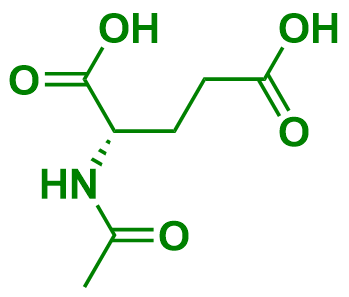N-Acetyl-L-Glutamic Acid Analysis Service
- Identification of metabolic disorders
- Drug development research
- Improving understanding of biochemical pathways
- Exploration of therapeutic potentials
- Animal tissue ≥ 100 mg
- Plant tissue ≥ 200 mg
- Serum/ Plasma ≥ 200 μL
- Urine ≥ 2 mL
N-Acetyl-L-glutamic acid is a bioactive compound that serves as a derivative of glutamic acid and plays an important biological role in living organisms. It is involved in various metabolic processes, particularly in amino acid metabolism and cellular signaling. The levels of N-aetyl-L-glutamic acid can reflect the metabolic state of cells, especially in response to nutritional changes and physiological demands. As a precursor of amino acids, N-aetyl-L-glutamic acid participates in the biosynthesis of various biomolecules, including neurotransmitters and other bioactive compounds. Its metabolites may also play significant regulatory roles within cells, helping to protect against oxidative stress and other environmental challenges. Monitoring the levels of N-aetyl-L-glutamic acid and its metabolites can serve as a biomarker for plants and animals in response to adversity, aiding in the improvement of adaptability and resistance, particularly in states of malnutrition or other stress conditions.

Figure 1. The Structure of N-Acetyl-L-Glutamic Acid
Mass spectrometry-based metabolomics methods can simultaneously detect and quantify thousands of metabolic features and are widely used for the metabolic analysis of various compounds. MtoZ Biolabs utilizes an LC-MS-based metabolomics research platform for the analysis of N-aetyl-L-glutamic acid. We ensure the accuracy of the quantification of N-aetyl-L-glutamic acid and its metabolites, as well as the comprehensiveness and precision of metabolite identification. If you would like to learn more about our N-aetyl-L-glutamic acid analysis services, please feel free to contact us, and we will be more than happy to assist you.
Analysis Workflow
Service Advantages
1. Experienced: MtoZ Biolabs has a professional research team and advanced technical equipment, capable of providing high-quality services and support to meet the specific needs of clients.
2. Wide Applicability: It is suitable for various types of samples, including plants, animals, and biological fluids, making it applicable across a broad range of fields.
3. High Throughput: Mass spectrometry technology can analyze multiple metabolites simultaneously in a short time, making it suitable for high-throughput analysis of large-scale samples.
4. Targeted Compounds: Targeted metabolomics focuses on specific metabolites, effectively eliminating interference signals and enhancing the reliability of the data.
5. Strong Detection Capability: Mass spectrometry technology can detect low concentrations of metabolites, making it suitable for analyzing rare or complex components in biological samples.
Applications
Sample Submission Requirements
1. Sample Types
Serum, plasma, urine, tissues and other biological samples. A minimum of 3 materials under the same condition for each sample is required.
2. Sample Volume
3. Sample Preservation
Samples should be stored at -80°C to maintain stability.
Note: Provide details on sample collection and handling.
Deliverables
1. Experimental Procedures
2. Relevant Liquid Chromatography and Mass Spectrometry Parameters
3. Detailed Information on N-Acetyl-L-Glutamic Acid
4. Raw Data
5. Custom Analysis Report
Through our N-acetyl-L-glutamic acid analysis service, we aim to facilitate your research and product development processes by providing accurate and reliable results.
How to order?







